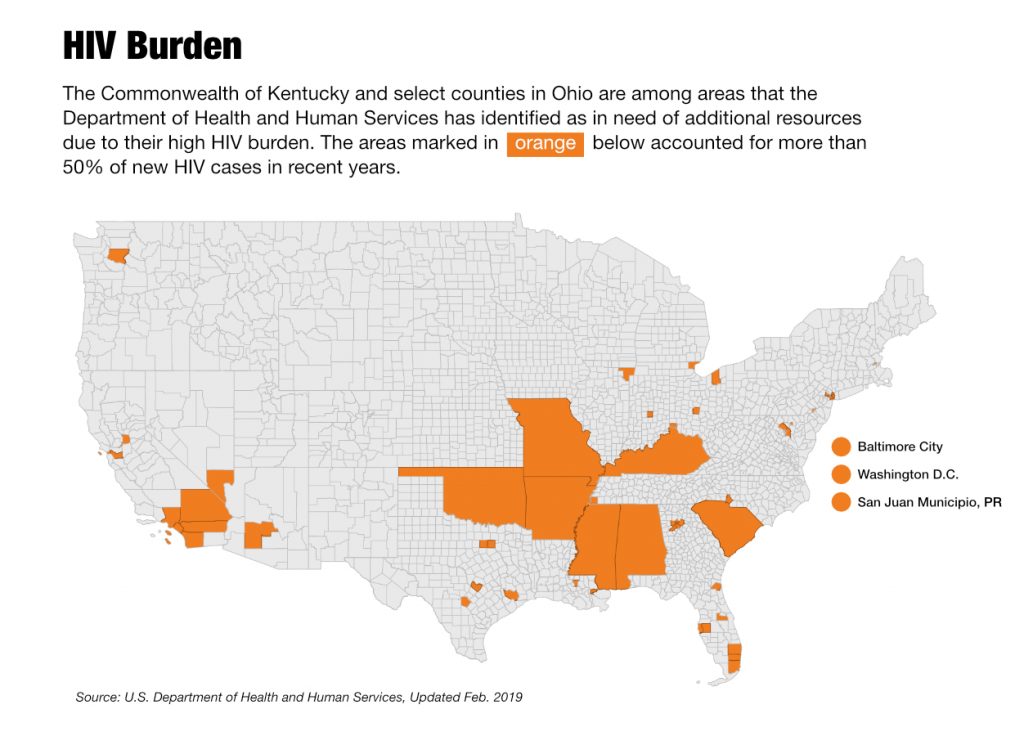News
HIV Infection “Clusters” Put Focus On Harm Reduction Programs
By: Mary Meehan | Ohio Valley ReSource
Posted on:
Health officials in Huntington, West Virginia, say a cluster of HIV infections has grown to 71 confirmed cases. That’s in a city that usually sees about eight HIV infections in a year. As with an earlier such cluster in northern Kentucky, officials say the primary cause of infection is needle drug use.
Health officials say a harm reduction program is an effective tool against HIV infection. The programs usually offer a syringe exchange, access to addiction counseling, and health screening services such as HIV testing.
The programs have expanded rapidly in the Ohio Valley, a region hit hard by the opioid crisis and at highest risk in the nation of infectious disease outbreaks due to needle drug use.

“The boomerang effect, the recoil, is going to be if these programs start closing, you’re going to see explosions of blood-borne pathogens, specifically HIV,” said Dr. Michael Brumage, director of the Preventive Medicine Residency Program in the West Virginia University School of Public Health.
High-Risk Region
In 2016 the Centers for Disease Control and Prevention spotlighted the counties in the U.S. at the highest risk of an HIV outbreak. Of the 220 high-risk counties, about a quarter were in Kentucky, West Virginia, and Ohio. The ten counties CDC found at highest risk were all in Kentucky and West Virginia.
Public health officials in the region have been working to implement syringe exchange harm reduction programs, which are widely supported as the most effective tool in combating HIV and other infectious diseases associated with needle drug use.
Dr. Greg Corby-Lee is the strategist with the University of Kentucky’s Harm Reduction Initiative. He said community-based harm reduction programs can be a lifeline to those still using drugs.
“It takes a while for them to build that level of trust up to come in,” he said. “That’s their one bridge, where they can be respected, and be given nothing but help to stay healthy.”
Corby-Lee said HIV prevention is the primary focus.
“That’s what they were designed for. But there are a lot of other benefits that come with it,” he said, such as peer counseling and screening for other diseases, such as Hepatitis C.

But he and other health officials also worry about a backlash brewing in many communities, threatening the harm reduction programs. They fear that misconceptions about the programs may threaten the very communities at greatest risk of an outbreak.
Daniel Raymond is Deputy Director of Planning and Policy for the National Harm Reduction Coalition. He said that while harm reduction programs are generally expanding, some are closing in the communities where they are needed most. The programs can become the focal point for other problems associated with the addiction crisis, he said, such as litter from used needles, homelessness, and petty crime.
“A lot of these programs have been starting in communities that don’t have a long history with harm reduction,” Raymond said. “So the programs that end up being at risk of closure are often the ones that are getting scapegoated for a community’s drug problem.”
Closure, Then A Cluster
Dr. Brumage says that’s part of the problem he encountered when leading a harm reduction program in Charleston, West Virginia. The program ended most of its services last year amid local political pressure and complaints about discarded needles.
“I think it’s a simplistic view to look at and blame one program for all of the city’s woes, with homelessness, with use, with all these other things,” Brumage said. “And I think that’s a trick that many politicians use very well, is to find a culprit scapegoat and to blame it rather than really looking at deeper issues.”

“Currently, some people in that community are saying, ‘Well, look, we have the syringe program, and we still got HIV, maybe we just need to close the program,’” he said. “The fact that you have a fire doesn’t mean you should close the fire department. You know, you bring more trucks on the scene.”
Brumage worries that the closure of the Charleston program may have contributed to the rise in HIV infections Huntington is now experiencing. The two cities are less than an hour’s drive apart along Interstate 64. And Brumage argues that Huntington’s cluster of infections could be much worse without a syringe exchange in place.
“My guess is had Huntington not had a syringe program, this problem would have exploded far worse.”
Other health officials say the growing HIV cluster in Huntington is a cautionary tale.
“It’s the looming disaster that we were all afraid of,” West Virginia University School of Medicine Professor Dr. Judith Feinberg told Mother Jones magazine.
Signs of Hope
Still, harm reduction proponents remain optimistic. The National Harm Reduction Coalition says that for every program closing, 20 more open. Kentucky has witnessed rapid growth in such programs.

“I never dreamed we’d have 56 programs,” he said. “I did not think as many communities would have said, ‘Yes, we have a problem, and yes, we’re addressing big issues.’ Those communities are much, much quicker in recognizing the problem than I thought they would. I’m glad to say, I was wrong.”
Bourbon County, Kentucky, is an example of the phenomenon Ingram is describing. After several failed votes the county approved a syringe exchange program last year. Judge Executive Mike Williams said he braced for the complaints and backlash.
“I got gas yesterday afternoon and had three conversations at the gas pump about three different things,” he said, but the syringe program was not one of the things people had concerns about.
Since the syringe program opened, helping about 100 people, he said he’s only heard concerns from three people.



